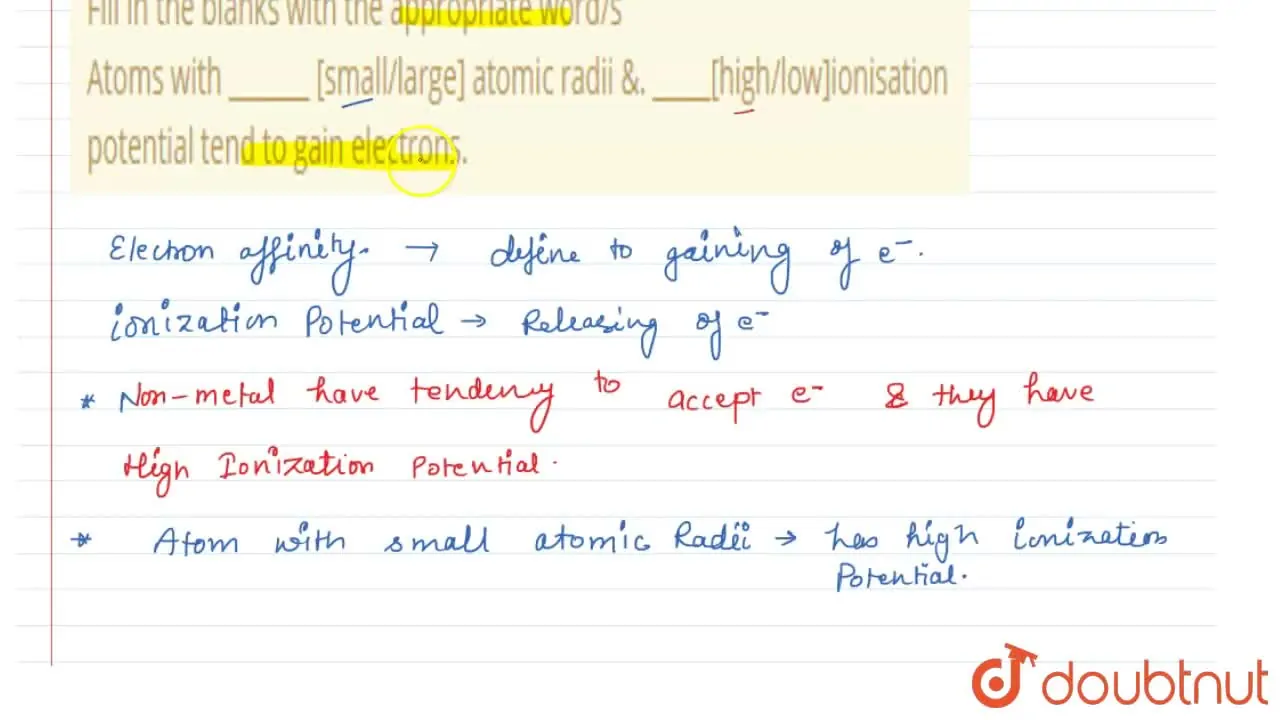Fill in the blanks with the appropriate word/s
Atoms with _______ [small/large] atomic radii &. _____[high/low]ionisation potential tend to gain electrons.
Step by step video & image solution for Fill in the blanks with the appropriate word/s Atoms with _______ [small/large] atomic radii &. _____[high/low]ionisation potential tend to gain electrons. by Chemistry experts to help you in doubts & scoring excellent marks in Class 10 exams.
Related Playlists
- BOOK - ICSECHAPTER - PERIODIC TABLE (PERIODIC PROPERTIES AND VARIATION OF PROPERTIES)EXERCISE - ADDITIONAL QUESTIONS (Give reasons for the following)10videos
PERIODIC TABLE (PERIODIC PROPERTIES AND VARIATION OF PROPERTIES)
- BOOK - ICSECHAPTER - PERIODIC TABLE (PERIODIC PROPERTIES AND VARIATION OF PROPERTIES)EXERCISE - UNIT TEST PAPER 1-Periodic Table22videos
PERIODIC TABLE (PERIODIC PROPERTIES AND VARIATION OF PROPERTIES)
- BOOK - ICSECHAPTER - PERIODIC TABLE (PERIODIC PROPERTIES AND VARIATION OF PROPERTIES)EXERCISE - ADDITIONAL QUESTIONS74videos
PERIODIC TABLE (PERIODIC PROPERTIES AND VARIATION OF PROPERTIES)
- BOOK - ICSECHAPTER - PERIODIC PROPERTIES AND VARIATIONS OF PROPERTIESEXERCISE - ASSERTION AND REASON BASED QUESTIONS5videos
PERIODIC PROPERTIES AND VARIATIONS OF PROPERTIES
- BOOK - ICSECHAPTER - PRACTICAL CHEMISTRY EXERCISE - Questions from Previous ICSE Board Papers (2017)2videos
PRACTICAL CHEMISTRY
Similar Questions
Fill in the blanks with the appropriate word/s
Atomic size of neon is ________ [more/less] than the atomic size of fluorine.View SolutionFill in the blanks with the appropriate word/s
An atom with a small atomic radii takes up electrons __________ [less/more] readily than an atom with a large radii.View SolutionFill in the blanks with the appropriate word/s
Argon in period 3 is likely to have a ________[larger/smaller] atomic size than chlorine and its electron affinity value would be _____ [Greater/lesser/zero] compared to chlorineView SolutionGive reason
Atoms with large atomic radii and low ionisation potential are more metallic in nature.View SolutionFill in the blanks with the appropriate word/s
An atom is said to be a non-metal if it ___[gains/Ioses] one or more electrons.View SolutionFill in the blanks with the appropriate word/s
Elements with low electronegativity are usually _______ [metallic/non-metallic]View SolutionFill in the blanks with the appropriate word/s
Increase in nuclear charge of an atom ________ [decreases/increases] the tendency of the atom to lose electrons.View SolutionFill in the blanks with the appropriate word/s
Nuclear charge of an atom is the ____ [negative positive ] charge on the nucleus of an atom, equivalent to the atomic ______ [number/mass] of an atom.View SolutionFill in the blanks with the appropriate word/s
Atomic size across a period ______ [increases/decreases] with increase in nuclear charge of the element.View SolutionFill in the blanks with the appropriate word/s
Elements with stable electronic configuration e.g. neon have an electron affinity value of ______ [1, 0,-1]View Solution


